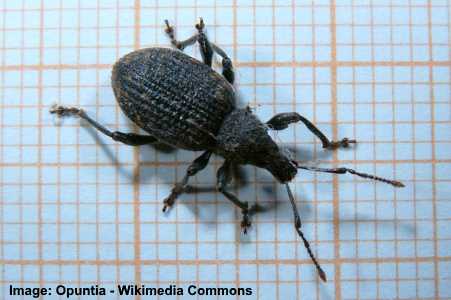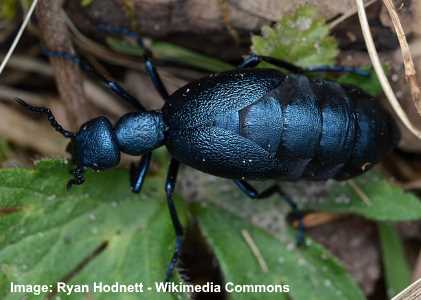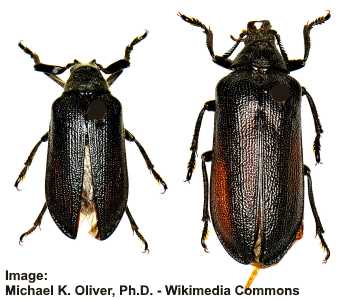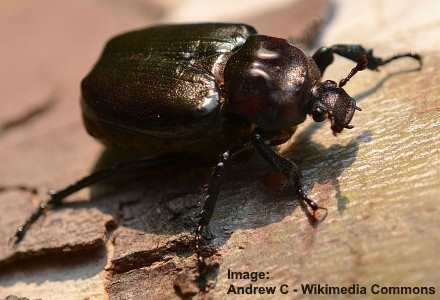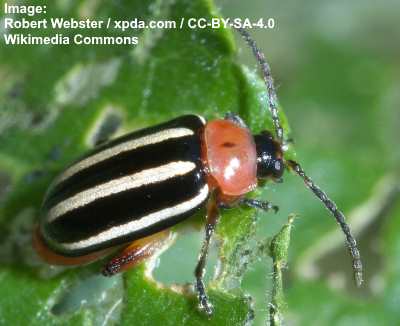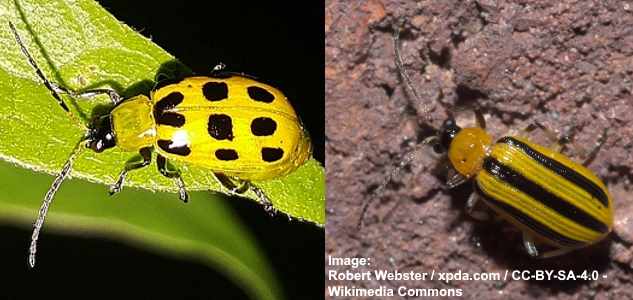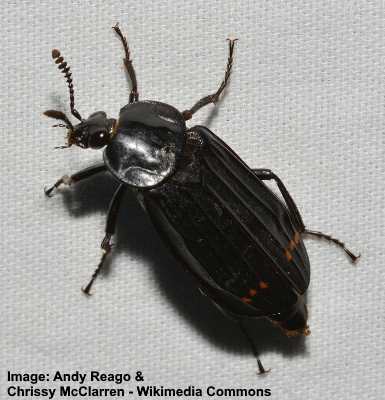32 Black Beetles: Identification Guide With Pictures
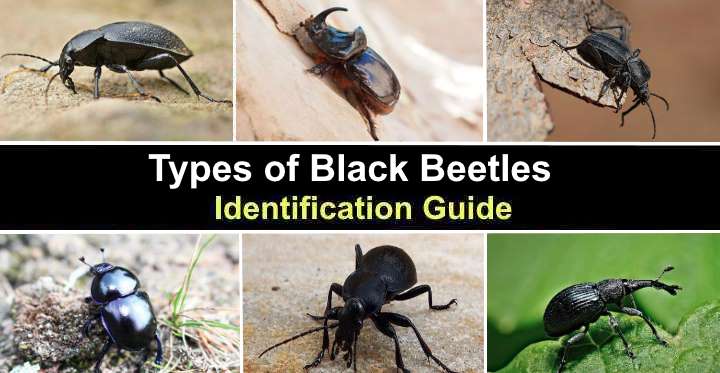
Black beetles are a common type of insect that are found in our homes and backyards. Some species of black beetle are completely harmless and can even help keep bugs out of your home. Although not all black beetles are regarded as pests, their larvae can be destructive. For example, black beetle larvae such as the carpet beetle can do a lot of damage to upholstery in your home.
All species of black beetle that inhabit homes are anthropoids in the insect order Coleoptera. There are thought to be over 400,000 species of beetles with weevils making up the largest of the beetle families. Groups of beetles are divided into families, genera, and then species.
Many people refer to any type of creepy-crawlies in the home as “bugs.” However, in the true sense of the word, beetles aren’t bugs. Unlike common household bugs, beetles chew their food with their jaws and their diet is a mixture of plant and animal sources. Although beetles can bite, they rarely bite humans and only become aggressive when threatened.
In this article, you will learn how to identify many common types of beetles that tend to live in houses. This information will help you to know what kind of black beetles you have at home.
Black Beetles Identification
Apart from their black color, you can identify black beetles by their hard shell, antennae, and pincers. Black beetles that invade homes tend to be smaller in size than the ones you may find crawling around your yard.
One of the identifying features of beetles is their unique hard wing cases or covers called elytra. Many types of beetle also use their wings to fly. This is one reason how carpet beetles get into homes. The beetles are attracted to light and fly in through open windows.
Black Beetles in House (With Their Picture, Common Name, and Identifying Details)
Let’s look in more detail as some of the most common black beetles you can find in your house. We’ll start with what many consider the most destructive type of beetle – the black carpet beetle.
Black Carpet Beetles (Attagenus unicolor)
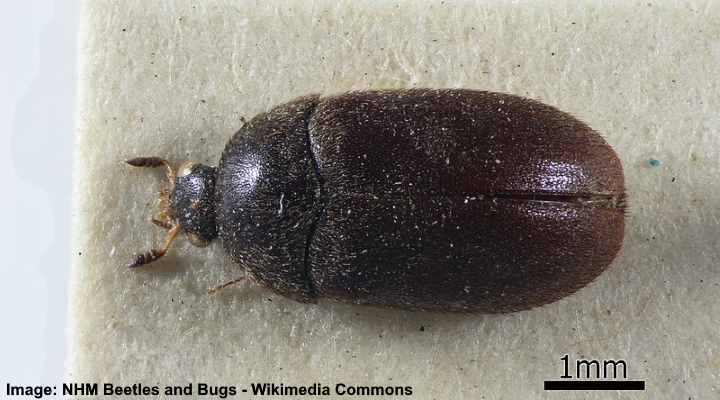
The small black carpet beetle is an indoor invasive pest
Attagenus unicolor is the scientific name for the black carpet beetle. These tiny black beetle bugs belong to the family Dermestidae and their larvae can be a true household pest.
These tiny carpet beetles start out their adult life as white beetles. As they mature, these “bugs” gradually become dark and black. Even though it is the larvae that cause destruction, you should get rid of the adults. Female black carpet beetles can lay up to 100 eggs, and their larvae can stay in the larval stage for up to 3 years.
Like most beetles, black carpet beetles have wings and they can fly. Although not always a pure black color, they are generally dark brown to black and may have lighter patterns on their elytra. Looking up close at pictures of black carpet beetles you may notice that they are covered in tiny hairs.
Black carpet beetles don’t bite humans. So, if you notice small bite marks on your skin, you may have a problem with other small house bugs (like bed bugs), not black beetles.
Beetle identification
- Carpet beetles are tiny black beetles that can be found in the house. They measure up to 0.1” (3 mm) in length.
- These small black bugs have short oval body and short inconspicuous antennae on their head.
- Slow-moving tiny black beetles that crawl or fly around homes.
- They can cause damage to natural cloth fibers or cereals. However, they don’t bite humans.
Common Furniture Beetle (Anobium punctatum)

As seen in the picture, the common furniture beetles are small dark beetles. They cause damage to timber and to household furniture
As its name suggests, the common furniture beetle (Anobium punctatum) can damage wooden structures and furniture. These dark-brown or black beetles are also called wood-boring beetles or house borers. They are also the cause of woodworm in many wooden items.
The common furniture beetle has a somewhat round black head and elongated body. These beetle pests have two antennae at the front of their heads. Looking up close at their picture, you may see fine lines running the length of its dark brown shiny back.
As with carpet beetles, the adult beetles don’t do any damage to homes. It is the larvae that bore into types of wood and can cause damage to timber. The effect of these burrowing grubs is woodworm that can weaken structures and destroy the look of furniture. Apart from tiny holes in wood, other signs you may have problems with furniture beetles are fine sawdust around furniture, crumbling wood, and adult beetles emerging from the holes.
Beetle identification
- Little dark-colored beetles that measure between 0.1” and 0.18” (2.7 – 4.5 mm) in length.
- The tiny beetle has long brown or black hardened wing cases.
African Black Beetle (Heteronychus arator)
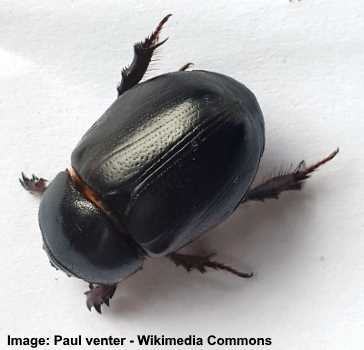
The tiny African black beetles have a shiny body with no antennae. This black beetle bug can be found in areas surrounding your house
You are more likely to see African black beetles (Heteronychus arator) around your home rather than inside your house. These pure black beetles are in the same subfamily as rhinoceros beetles (Dynastinae), only not as large.
These shiny black beetles have a short oval body without any significant markings. The underside of these small black “bugs” reveals rusty brown markings that help distinguish it from other beetles.
Native to Africa, these little black beetles are common agricultural pests in Australia and New Zealand. Some studies show that these tiny black beetle bugs are invasive pests in many tropical and subtropical climates. The adults feed on legumes and potatoes, and the soil-burrowing larvae can destroy grass from feeding on the roots. (1)
Because the beetles and their larvae can destroy grass, they also have the name ‘black lawn beetle.’
Beetle identification
- Shiny black beetles that measure between 0.4” and 0.6” (12 and 15 mm) long.
- An oval head and oval body with no antennae and short jaggy-looking feet.
Black Vine Weevils (Otiorhynchus sulcatus)
Weevils make up the largest family in the insect order of Coleoptera and there are many black species of these beetles. Weevils are in the superfamily Curculionoidea and are generally small-sized beetles.
One of the weevil species that is the most annoying garden bug is the black vine weevil (Otiorhynchus sulcatus). This black beetle pest can’t fly because its wing cases are fused together. The vine weevil beetle has a dull black body with slightly raised bumps on it. Compared to its oval body, its head is small and long. These black beetles also have two long antennae that they use to smell out plants to feed on.
Weevils are not a type of black beetle that bite humans and their presence in the house is more of a nuisance. However, they can do a lot of damage to your backyard. These pesky black bugs feed on plants such as asters, lilies, rhododendrons, and lilac.
Beetle identification
- Small black beetles measuring about 0.5” (12 mm) long.
- Found throughout North America where they are a major garden pest.
- Their shape is an oblong oval gray to black body with a smaller thorax and even smaller head.
American Oil Beetle (Meloe americanus)
American oil beetles belong to the beetle family Meloidae and belong to the genus Meloe. These are a large beetle species that have an iridescent shiny black body that is massive in relation to its head and thorax.
These big black beetles get their common name from an oily substance they emit when disturbed. This poisonous chemical can cause skin blistering which is why they are also called ‘blister beetles.’ They have 2 antennae that point up like an upside-down L shape. They are also identified by their long spindly legs attached to their thorax that carry their oversized body.
Although oil beetles have wings, they are generally flightless insects and prefer to slowly move around looking for plant material to feed on.
Beetle identification
- A large slow-moving beetle that measures up to 1.2” (30 mm) long.
- Bumpy black body with hints of metallic greens from the iridescent coloring.
- Found in undergrowth and can’t fly.
Black and Red Blister Beetle (Megetra cancellata)

Megetra cancellata has black body with red bands
The beetle Megetra cancellata is commonly known as the black and red blister beetle. Being a member of the beetle family Meloidae, the menacing-looking beetle can cause skin blistering if you touch it.
The black and red blister beetle is found in southern states in the US and in Central America. The beetle has a humpbacked body that is in the shape of a tear. Some say that this large red and black beetle looks like a tiny armadillo.
As with other blister beetles, this species has a small head in relation to its hard-shelled body. The shiny black body has red bands or stripes wrapping around it. This beetle species doesn’t fly and it has two wing-like black and red parts attached to its thorax.
Beetle identification
- Shiny black and red striped beetle that measures between 0.4” and 0.6” (10 to 15 mm) long.
- Moves slowly through undergrowth.
Cedar Beetle (Sandalus niger)
One type of black flying beetle is the cedar beetle (Sandalus niger) which belongs to the family of insects Rhipiceridae. Cedar beetles are also called ‘cicada parasite beetles’ because they feed on bugs in the family Cicadoidea.
When looking at pictures of their elytra, these beetles look pure shiny black with their oblong bodies. The abdomen of these fascinating flying insects is orange which you can see when they open their wings to fly. Cedar beetles, especially the males, actively fly during warm days and may be mistaken for fireflies – also a type of beetle.
Beetle identification
- Tiny flying black beetles that measure between 0.08” and 0.2” (2 to 5 mm) long.
- Often seen around elm trees where the females like to live.
Rhinoceros beetle (Xyloryctes jamaicensis)
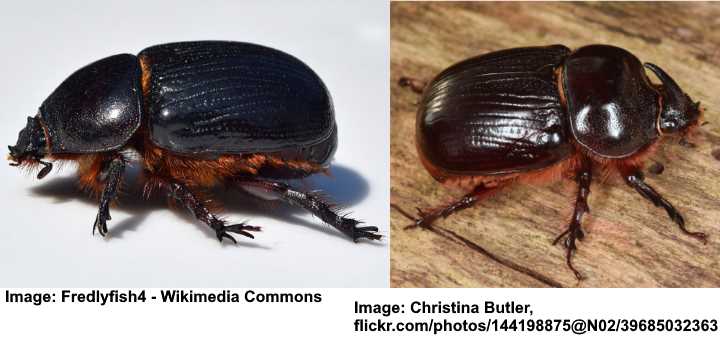
The large brown-black rhinoceros male beetle (right) has a single horn on its head whereas the female (left) lacks it
Also called the unicorn beetle, the rhinoceros beetle (Xyloryctes jamaicensis) is a large black or dark brown harmless beetle. The beetle belongs to the family Scarabaeidae and is also referred to as a scarab beetle.
One of the identifying features of these large beetles is the single horn on their heads. The prominent rhinoceros horn gives the beetles a menacing look. The beetles are slowly moving through woodlands and forests where they feed on dead roots. The beetles look shiny black from above and they have an orange underside. They are also a species of flying beetle; however, they rarely take to the air.
Beetle identification
- Large shiny black beetles that measure between 0.82” to 1.3” (21 to 33 mm) long.
- Beneficial black beetle with a fat body, protruding single horn, and hard exterior.
Black Stink Beetles (Eleodes)
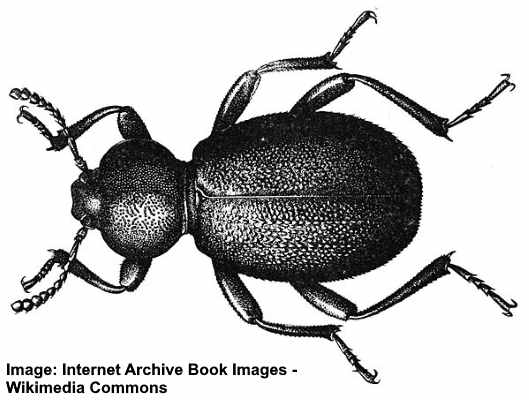
Black stink beetles don’t fly and defend themselves by producing a stinking chemical
Stink beetles are also called pinacate beetles and are a group of black beetles in the genus Eleodes. The name ‘pinacate’ is an Aztec word which literally means “black beetle.”
As their name suggests, these beetles are famous for producing a stinking chemical as a defensive mechanism. When threatened, they have an unusual behavior of standing on their head and squirting a malodorous substance. This behavior has earned them other names such as ‘stink bug,’ ‘clown beetle,’ and ‘skunk beetle.’
Stink beetles don’t fly and move around slowly on their legs. Some species of desert stink beetles have satin-black oblong bodies that taper to a point. Other pinacate beetles have an oval body with a smaller oval thorax and tiny head.
Beetle identification
- Large beetles that inhabit warm and temperate regions. They grow to between 1” and 1.3” (25 to 35 mm) long.
- A pair of legs attach to the thorax and 2 pairs of legs attach to their abdomen. They also have long searching antennae.
Hermit Flower Beetle (Osmoderma eremicola)
Hermit flower beetles (Osmoderma eremicola) are a type of scarab beetle that has a shiny jet-black fat oval body. These hermit beetles are solitary insects that are among the larger species of beetle.
Their scientific name means ‘smelly skin’ and describes the strong pungent odor these black “bugs” give off. Apart from their shiny hard shell, the beetles are identified by the dimple on their thorax and between their eyes. Hermit flower beetles are beneficial insects that only feed on dead or decaying wood.
Beetle identification
- Big black shiny beetles that grow up to 1.17” (30 mm) long.
- Flies at night time and is attracted to lights. During the day it slowly moves through undergrowth in wooded areas.
Pigweed Flea Beetle (Disonycha glabrata)
One of the more unusually-colored black beetles is the pigweed flea beetle (Disonycha glabrata). This striped beetle from the family Chrysomelidae has a black body with white stripes running down its length.
Pigweed flea beetles are found in the Eastern and Central regions of North America. The black and white beetle is quite small in size and can be found feeding on pigweed plants. Another interesting feature is its black and red head. The tiny black beetle also has two black antennae and 6 red and black legs.
Beetle identification
- This small oblong beetle is around 0.2” (5 mm) long.
- Its black and white stripes make this tiny beetle stand out against green vegetation.
Cucumber Beetles (Diabrotica undecimpunctata, Acalymma vittatum)
Some beetles in the family Chrysomelidae have striking yellow and black markings and are crop pests.
The spotted cucumber beetle (Diabrotica undecimpunctata) and striped cucumber beetle (Acalymma vittatum) are both tiny garden beetles. Contrasting black and yellow markings identify their spotted or striped species. The cucumber beetles are crawling insects that feed on the leaves of legumes, cucumber, corn, and squash.
Beetle identification
- Small, but destructive beetles that measure around 0.2” (5 mm) long.
- Black and greenish-yellow markings identify many beetles in the genus Acalymma and Diabrotica
Red-Lined Carrion Beetle (Necrodes surinamensis)
The red-lined carrion beetle (Necrodes surinamensis) has long ridged black wing cases with reddish-orange marks on them. This beetle has a shape that is not oval like many types of beetles. The wing cases have straight edges with slightly rounded ends.
When the carrion beetle gets ready to fly, the elytra opens up to reveal orange translucent wings over a black abdomen. These beetles feed on a diet of maggots that live on rotten flesh. Identification of beetles of the Silphidae family is also by the foul odor that the carrion beetles emit.
Beetle identification
- Medium-sized beetles that grow to between 0.5” and 1” (12 and 25 mm) long.
- Hard black elytra with ridges and orange markings identify this beetle.
White-Spotted Sawyer Beetle (Monochamus scutellatus)
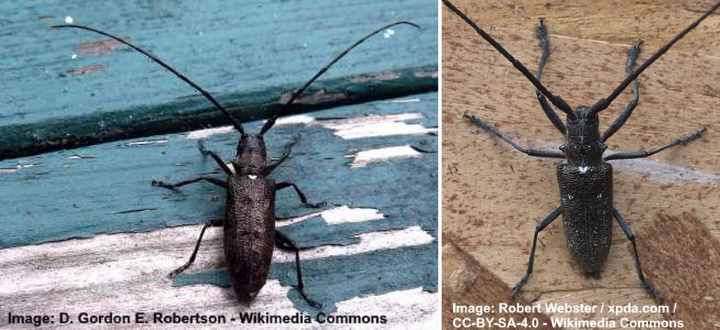
The White-Spotted Sawyer Beetle has long antennae and may have white spots on the body
The white-spotted sawyer beetle (Monochamus scutellatus) belongs to the subfamily Lamiinae and is known for its long antennae. The long-bodied beetle may have white and black markings on its wing covers.
These sawyer beetles are a type of longhorn beetle. The term ‘longhorn’ comes from their exceptionally large antennae on their heads. In some species, the antennae can be 3 times the length of the bodies. These are black beetles that may have white speckling on their wing cases. They also have a white heart-shaped dot on their thorax.
These black beetles with white markings are common in pine and spruce forests in North America. The females produce larvae that bore into cut or dead pine wood. The sawyer beetles are a destructive pest causing damage to timber before it can be treated.
Beetle identification
- Large beetles measuring up to 1” (25 mm) in length.
- Two large antennae on their head can be as long as 3” (75 mm).
Pennsylvania Ground Beetle (Harpalus pensylvanicus)
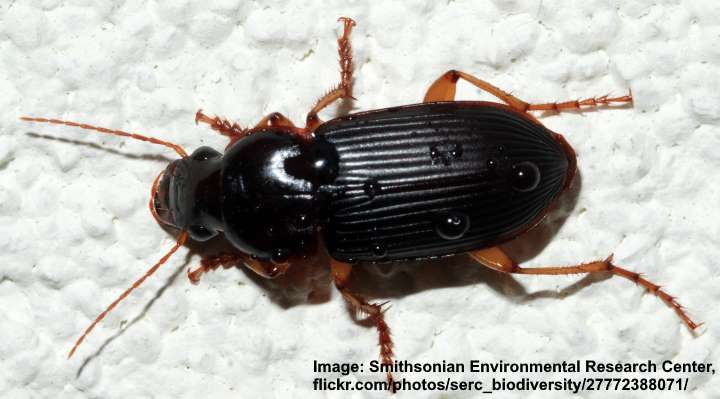
Pennsylvania ground beetle has a shiny black ridged body with brown legs and thin long antennae
The Pennsylvania ground beetle is a native black beetle that sometimes finds its way into homes. This beetle is identified by its shiny black body, reddish-brown legs, large mandibles, and filiform antennae. The ground beetle also has noticeable lines along its elytra (wing covers).
The Pennsylvania ground beetle measures 0.51” to 0.63” (13 – 16 mm). The black beetles become more active in August and September when they may enter homes. The small black “bugs” in the house are usually found in damp areas, basements, or under objects lying on the floor.
The beetles have a habit of being attracted to lights. As a result, they will often get into houses through cracks in the foundation or the base of door frames. Although the ground beetles have wings, they rarely fly.
Beetle identification
- Small black shiny beetle measuring up to 0.63” (16 mm).
- Oval body with ridged wing covers, brown legs, and brown antennae.
- Typically found in dark places.
Big Headed Ground Beetle (Scarites subterraneus)
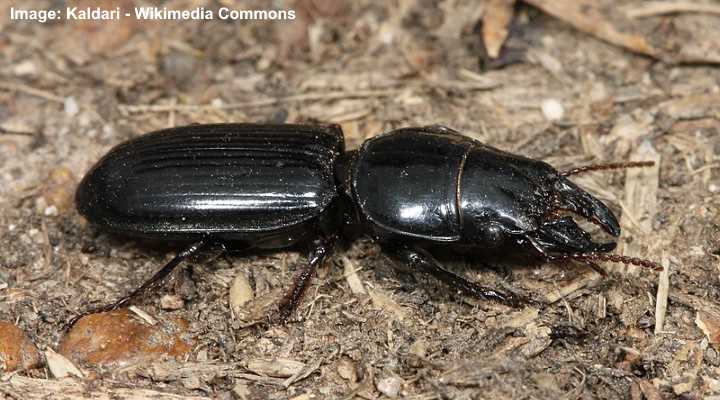
The big headed ground beetle has a shiny black body with an unusually large head and mandibles and short antennae
The big-headed ground beetle is a sizable black beetle with an unusually large head for a species of ground beetle. The large black beetle has a shiny black oval body, a large head, and enormous mandibles. In addition, the carabid (ground) beetle has short dark brown serrated antennae.
As one of the largest black ground beetles, the big-headed ground beetle measures up to 0.88” (22.5 mm). Due to the beetle’s size and pronounced mandibles (pincers), it is sometimes confused for a black stag beetle. Additionally, its big head and big jaws make up half the length of the sizable black beetle.
Although the big-headed beetle gets into homes, they rarely become pests. However, because it’s a predatory insect, it may help to keep unwelcome pests out of your home. The big black beetle feeds on aphids, slugs, caterpillars, spiders, and other arthropods.
Beetle identification
- Shiny black flattened body with a large head and pinchers.
- Noticeable grooves on its elytra.
Larder Beetle (Dermestes lardarius)
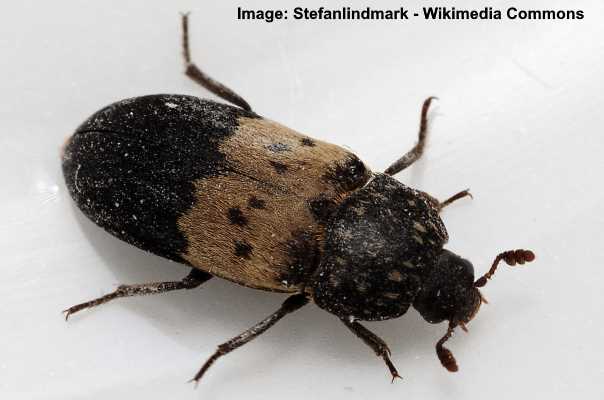
The small brown and black larder beetle is a household pest that feeds on dried foodstuff
The larder beetle is a small, oval black bug with a brown pattern on its furry wing covers. This household pest is identified by the yellowish-brown band on its back and three dots in a triangular shape. The tiny black beetle is covered in fine black or brown setae and has clubbed antennae.
Also called the moisture bug, a larder beetle measures between 0.33” and 0.37” (8.4 – 9.5 mm). It gets its name because it infests areas where food is stored. The small black and brown beetle eats cheese, dried meats, fish, and pet food.
To control the little black beetles in the house, it’s crucial to ensure foodstuffs aren’t left out, including pet food. Additionally, you should caulk all cracks and screen openings to prevent the small beetles from getting indoors.
Beetle identification
- A cream to yellowish-brown band across the elytra with three dark dots on each side.
- A dark reddish-brown to black cover with short clubbed antennae.
Granary Weevil (Sitophilus granarius)
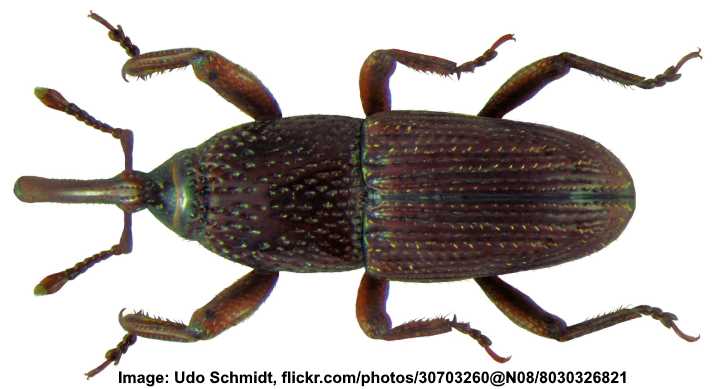
Granary weevils are identified by their dark brown or black body with ridges and a long snout
The grain weevil is a tiny black or dark brown beetle with reddish-brown legs, antennae, and a long distinctive snout. The identifying features of this black insect are its pitted mark on its thorax and ridges along its back. Because the beetles are so small, they are hard to identify without a magnifying lens.
Also called the wheat weevil, a granary weevil measures 0.12” to 0.20” (3 – 5 mm) long. The flightless creatures are typically found in stored grains in a pantry. You may see signs of these annoying black “bugs” in packets of rice, corn, oats, barley, rye, millet, sorghum, and wheat.
Beetle identification
- A dark reddish-brown, sometimes black body, with an elongated snout.
- Punctuation marks on its thorax and ridges along its back.
Black Click Beetles (Melanotus spp.)
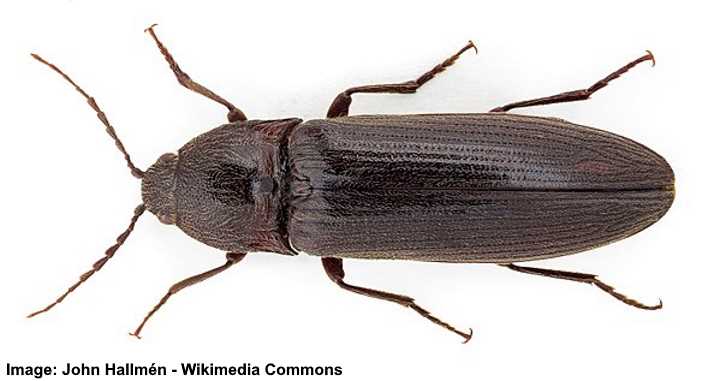
The black click beetle (Melanotus castanipes) has a black elongated body and thin long antennae
Finding a long black beetle in the house could mean you have black click beetles. These slender, elongated six-legged black insects are relatively harmless. The flying black beetle has a long, oval body, short head, and a pair of filiform antennae.
A black click beetle measures 0.39” to 0.70” (10 – 18 mm) long. Apart from the dark brown or black slender bodies, their identifying feature is the clicking noise they make. If the beetles need to make a quick getaway, they snap their stiff spines, making an audible clicking noise.
Beetle identification
- Rusty-brown to black, slender body with long antennae.
- They are recognized by clicking noise when they move quickly.
Eastern Eyed Click Beetle (Alaus oculatus)

The eastern eyed click beetle has a slender black body with white specks and unusually large eye-like spots
The eastern-eyed click beetle has a distinctive slender black body covered in white speckles. The unusual feature of this long black beetle is the two large spots on its head that look like large eyes. Like all species of click beetles, this black insect makes an audible click if it moves quickly.
The eastern-eyed click beetle grows 1” to 1.8” (25 – 45 mm) long. The black beetles rarely get into houses but spend most of their time in forests. Typically, the mature beetles don’t cause damage. Instead, they feed on nectar and plant juice. Their larvae — called wireworms — feed on wood-boring beetle grubs.
Beetle identification
- Unusual large black and white circles on a grayish-black head that resemble two oval eyes.
- Elongated black elytra covered in silvery white dots.
Bombardier Beetles (Brachininae spp.)

The small bombardier beetle is identified by its orange-brown head and black oval body
Bombardier beetles are a genus of black and orange beetles that typically live on the ground. The appearance of the beetles is a black, oval-shaped body with a reddish-brown or dark orange head, thorax, antennae, and legs. This unique beetle has a defensive habit of emitting a hot, irritating liquid.
Many species of bombardier beetles are small orange and black beetles measuring 0.17” to 0.37” (4.5 – 9.5 mm). The tiny beetles are typically active at night and rarely enter homes. The carabid beetles generally are found in grasslands, under rocks, or debris, especially in damp, boggy environments.
Beetle identification
- Flattened mat-black wing covers with orange-brown head, legs, and filiform antennae.
- The black and orange beetles squirt an irritating hot liquid to ward off predators.
False Bombardier Beetle (Galerita bicolor)
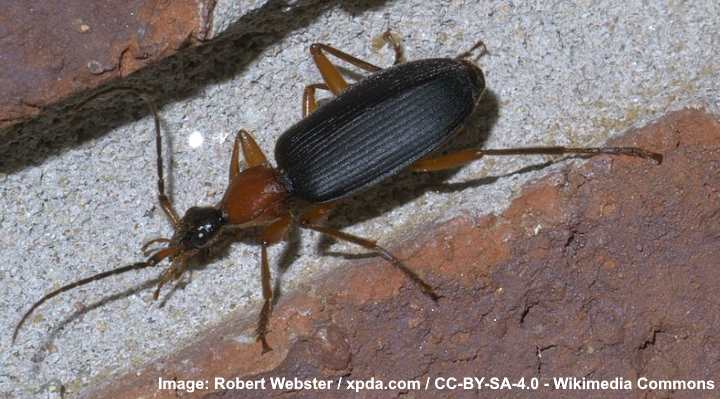
The black and orange false bombardier beetle has a long and slender body and is relatively large
The false bombardier beetle is a type of ground beetle with a black body and orange-brown legs. This black and orange beetle has long black, slender elytra with linear ridges, long orange-colored antennae, and small pincers. Visually, Galerita bicolor looks like a bombardier beetle but has a longer, slenderer body.
The false bombardier beetle is a relatively large beetle measuring 0.68” to 0.88” (17.5 – 22.5 mm). Although the orange and black insect inhabits woodlands and grassy areas, they can get into homes. In this case, you should be careful handling them as they also emit a stinging spray to defend themselves.
Beetle identification
- A slender black and orange beetle with a pair of long antennae.
- Long orange legs.
- Linear ridges on the black wing cases.
Black Caterpillar Hunter Beetle (Calosoma sayi)
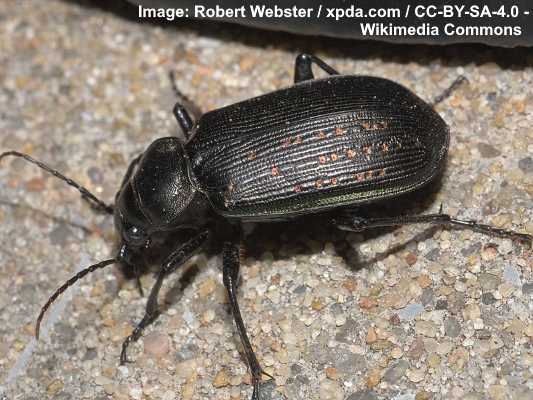
The black caterpillar hunter beetle has brown dots on its wing covers and large jaws
The black caterpillar hunter beetle is a large black insect with a shiny black oval body. Identifying features of this large black beetle are rusty-colored spots on its ridged wing covers. Additionally, the large beetle has large jaws it uses to catch and devour its prey.
The black caterpillar hunter beetle grows 1” to 1.10” (25 – 28 mm) long. As its name suggests, this black outdoor beetle mainly feeds on moth and butterfly caterpillars. The behavior of these black beetles is that they are attracted to lights and primarily come out at night.
Beetle identification
- Shiny black beetle with metallic rusty-red spots on its grooved elytra.
- Some species have an iridescent green sheen.
- Feeds on various species of caterpillars and insect larvae.
Giant Stag Beetle (Lucanus elaphus)
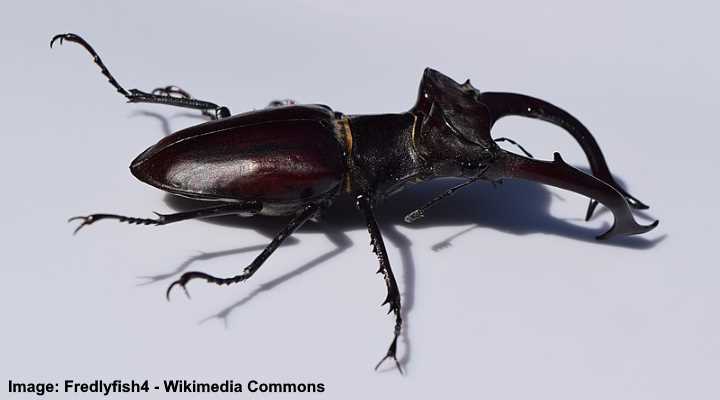
It is easy to identify the giant stag beetle due to its enormous pincers
The giant stag beetle is one of the most recognizable large black beetles due to its huge pincers. The large dark maroon pincers and head of this enormous beetle seem larger than its abdomen. Although this is a flying black beetle, stag beetles tend to scurry across the ground.
Stag beetles are enormous black insects measuring around 2.3” (60 mm). Also called the elk beetle, the characteristic feature of the hard-shelled beetle is its powerful antler-like jaws with forked teeth. Some stag beetles appear reddish-brown rather than shiny black.
Although some call this the elephant beetle due to its size and scientific name, the Latin name elaphus means “stag.”
Beetle identification
- Enormous black or maroon-brown beetle with large, elongated pincers.
- A distinctive plate-like covering on the head protects the thorax.
Hermit Flower Beetle (Osmoderma eremicola)
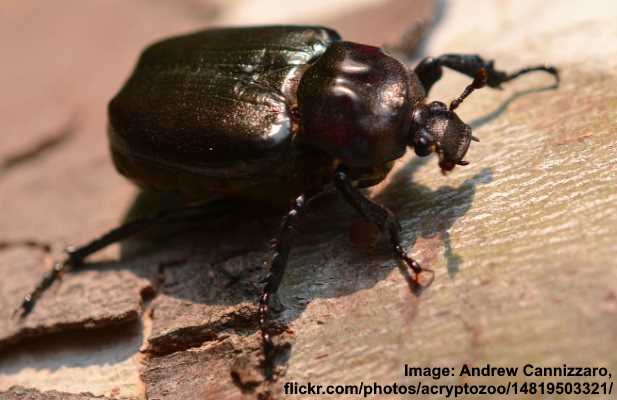
Hermit flower beetle has a shiny large black or dark brown body and a distinct odor
The hermit flower beetle is a large, shiny black scarab beetle commonly found throughout North America. The dark mahogany brown or black beetle has a shiny oval body that is slightly rounded. The harmless beetles fly and are attracted to lights. Because of its distinct leather odor, it’s also called the leather beetle.
The hermit flower beetle measures 1” (25 mm) long and is one of the largest black scarab beetles. Some people call this the Junebug because of its resemblance to blackish or reddish June beetles. Although the sizable black beetle is considered a pesky bug, it’s harmless and won’t harm humans or damage property.
Beetle identification
- Glossy dark brown or black beetle with no distinguishable markings or spots.
- Short stumpy club antennae.
- Broadly dark-colored oval wing cases.
Horned Passalus Beetle (Odontotaenius disjunctus)
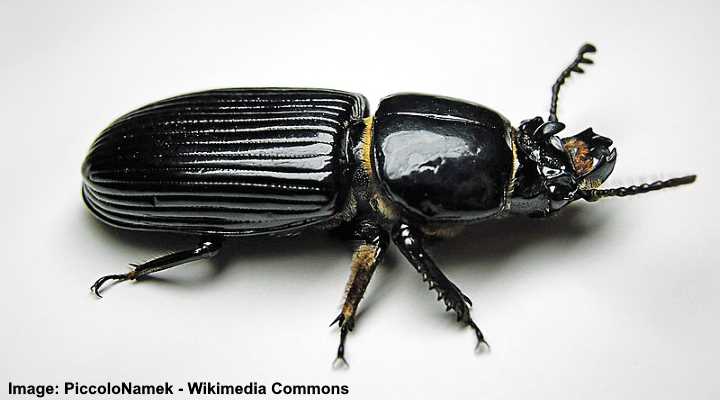
The large horned passalus beetle has a shiny black body with grooved wing covers and a horn on its head
The horned passalus beetle is a large, shiny black beetle with grooved wing cases and a prominent curved horn on its head. An interesting feature of this black-horned beetle is the orange-brown hairs on its legs, antennae, and around its pronotum (the plate covering the thorax).
Also called the bess beetle or peg beetle, this large black beetle measures 1.25” to 1.40” (32 – 36 mm) long. Although shiny black is its main identifying characteristic, it can also appear dark brown with hues of orange or maroon. You will find this chunky beetle in woodlands eating decaying wood.
Beetle identification
- The large glossy black beetle has a lustrous sheen like patent leather.
- Short orange hairs cover parts of its body.
- It emits a kissing sound when handled.
Winter Firefly (Ellychnia corrusca)
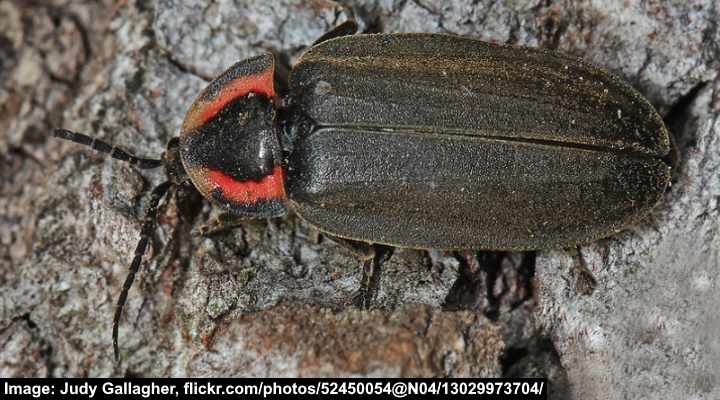
Winter firefly is identified by its black elongated body and two red stripes on its head
The winter firefly is a type of tiny black beetle with elongated dark brown to black wing covers and a shiny black thorax with two red stripes. Winter fireflies are an interesting insect species because unlike the eggs, larvae, and pupae, the adults can’t glow like typical fireflies; therefore, they are called a “lantern-less” beetle.
The small black flying beetles measure up to 0.47” (12 mm) long. You will often find the small black beetles in coniferous forests where pine trees are abundant. However, they are also a nuisance in deciduous forests where maple trees grow and are often found floating in maple sap buckets — hence the other common name, sap bucket beetle.
Beetle identification
- Elongated wing cases are dark brown to black, with two red stripes on a black head.
- Commonly found on the sides of homes and other structures.
American Carrion Beetle (Necrophila americana)
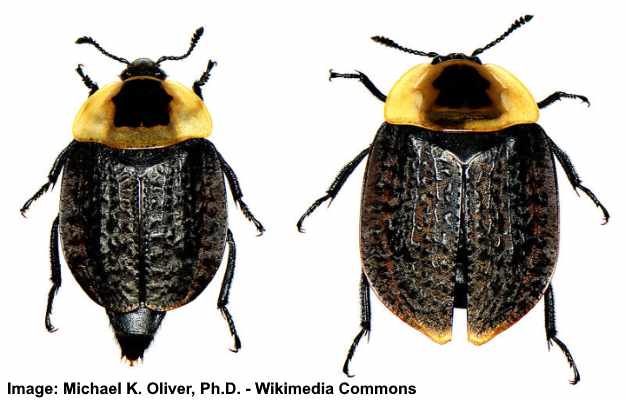
In the picture: American carrion male beetle (left) and female (right)
The American carrion beetle is a yellow and black beetle with a distinctive broad, oval body. This glossy black beetle has bumpy, patterned wing covers with slightly reddish patterns. However, its most distinctive feature is the bright yellow pronotum with a large black patch in the center.
The overall shape of the American carrion beetle is like a shield. This makes the black beetle resemble bugs like the stink bug or shield bug. The American carrion beetle measures 0.47” to 0.86” (12 – 22 mm) long. It’s a large black bug-like insect with a hard shell.
This large black beetle is known for feeding on decaying flesh, rotten fruit, larvae, dead skin, and dead tissue.
Beetle identification
- The black beetle has a bumpy black shell and bright yellow shoulder section with a distinctive black mark.
- Often found feeding on rotten food or animal carcasses.
Punctured Tiger Beetle (Cicindela punctulata)
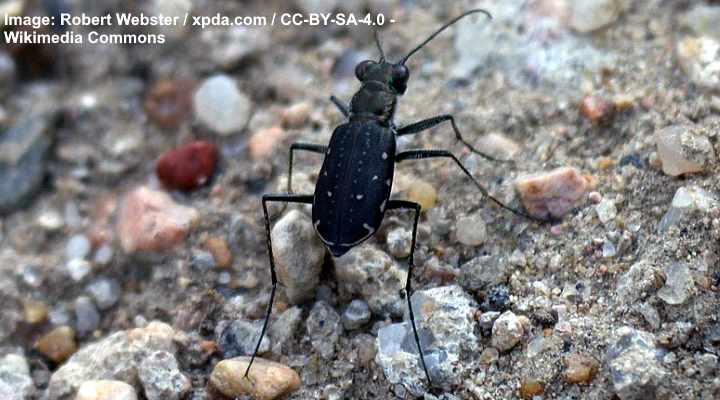
The black punctured tiger beetle has white markings on its body as well as long thin legs and bulgy eyes
The punctured tiger beetle is a small, slender black beetle with dull white markings on its oval wing covers. Other distinctive features of the typical black beetle are its thin, spindly legs, bulging eyes, and long antennae. The small beetle measures 0.43” to 0.51” (11 – 13 mm) long.
Although dull black with faint white spots is its typical coloration, the slender beetle can also have iridescent green or bronze colors. The thin legs can also have fine setae covering the upper sections. It also goes by the name sidewalk tiger beetle.
Beetle identification
- A slender mat-black elongated oval body with grayish-white markings along the margins and a row of dots down each wing cover.
- Bulgy eyes.
- Thin long legs and antennae.
Broad-necked Root Borer (Prionus laticollis)
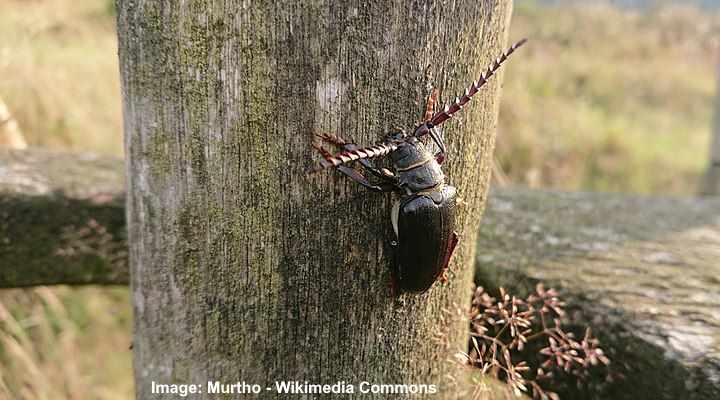
The large dark brown or black broad-necked root borer has big serrated antennae
The broad-necked root borer is a large dark chocolatey-brown or blackish flying beetle with huge, serrated antennae. As its name suggests, this black beetle is identified by a broad thorax and has spikes along the edges. The enormous black beetle measures 1.77” (45 mm) long.
Broad-necked root borer beetles are active in the summer and typically inhabit forests and woodlands. However, if your house is near wooded areas, the black flying beetles may be attracted to lights and hit windows with a loud bang at nighttime. They are almost as large and as heavy as rhinoceros beetles.
Beetle identification
- Black or dark brown body with a yellow underside.
- Distinctive straight antennae with 12 segments.
- A broad neck and small head with two long antennae attached.
Twice-Stabbed Ladybug (Chilocorus stigma)
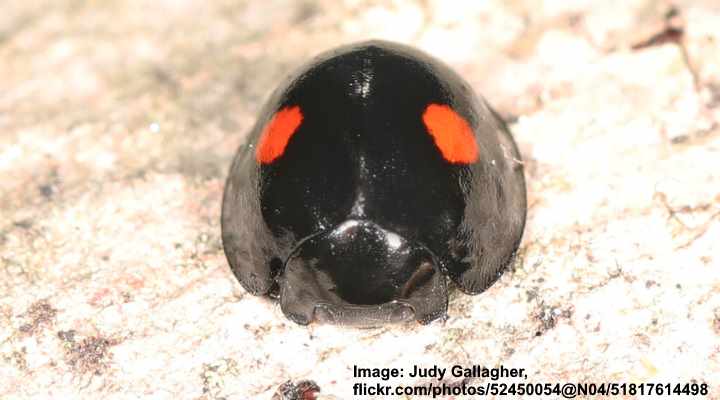
The tiny twice-stabbed ladybug has a rounded shiny black body with two red spots
The twice-stabbed ladybug is a small black flying beetle with a hard shell. The small shiny black beetle with its domed wing covers has a distinctive red spot on each one. When the beetle flies, you’ll notice that its body is also black but has a yellow abdomen.
The twice-stabbed lady beetle is a tiny flying insect that measures 0.14” to 0.19” (3.75 – 5 mm). Like most ladybugs, this minute beetle is recognized by its rounded elytra. However, whereas most lady beetles are predominantly red with black dots, this species is black with two red spots.
Beetle identification
- Tiny, shiny black ladybug with domed wing covers, each having a red dot.
- The black lady beetle with red spots is recognized as a beneficial insect that preys on plant pests.
Sugarcane Beetles (Euetheola humilis)
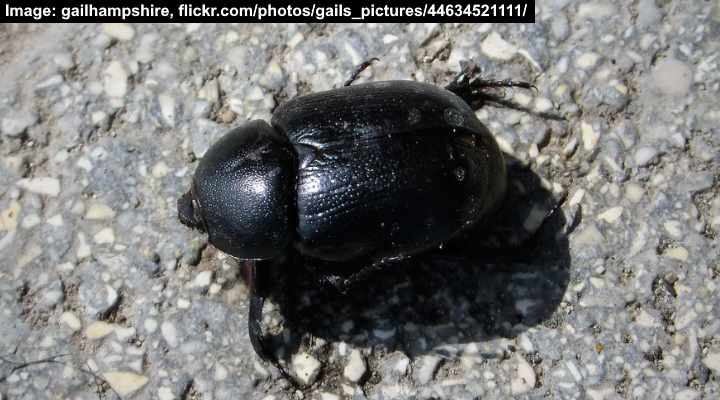
The small black sugarcane beetle has a tiny head and tiny club antennae and is covered with a hard shell
The sugarcane beetle is a robust, shiny black beetle with a hard shell, small wavy pincers, and tiny club antennae. Up close, pictures of the small oval black beetle show rows of pitted dots on its wing covers. And in relation to its oval, rounded body, the small beetle has a tiny head.
The sugarcane beetle measures 0.5” (13 mm) long. The black beetle is common in the southeastern United States, where it feeds on roots and stems of sugarcane, rice, sweet potatoes, and turfgrass.
Beetle identification
- Shiny black domed wing covered with several rows of small indentations.
Related articles:
- Types of Beetles With Pictures and Identification Guide
- Types of Insects with Pictures and Names
- Types of Ladybugs: Classification, Asian Lady Beetle vs. Ladybug

